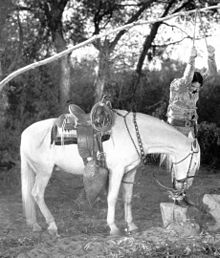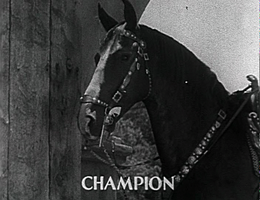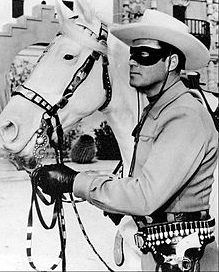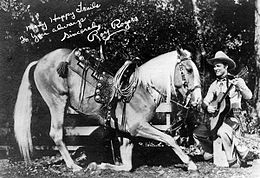

"The phrase Wonder Horses refers to the equine companions of cowboy heroes in early Western films. What makes these horses different from others that have appeared on the silver screen is their rise from trusty steed to a genuine screen personality. There have been a number of horses who have enjoyed such fame, often receiving equal or second billing with their human costars.
Heroic Horses of the Silver Screen
Though the first heroic horses emerged from the silent film era, they were prominently featured in the B-Westerns of the 1930s, 1940s, and 1950s. During the early decades of sound film, cowboy movies targeted a juvenile demographic. The films' heroes were generally one-dimensional, stock characters who represented and promoted truth and goodness to their young audience. More popular with adolescent viewers than a human sidekick, the Wonder Horse could not only outrun the mounts of the villains, but could also perform a series of feats and tricks to ensure that the cowboy hero would triumph.
The bond between a cowboy and his horse is an important part of the cowboy mythology created by dime novels, pulp fiction stories, and Western cinema. Movies featuring Wonder Horses embellish this relationship between man and beast while heightening the exceptional and heroic qualities of the cowboy by his association with a remarkable animal.
Fritz
Fritz was the first horse to be named in the credits as a costar to his rider, William S. Hart, appearing in at least eight silent films: Pinto Ben (1915), Hell's Hinges (1916), The Narrow Trail (1917), Blue Blazes Rawden (1918), The Toll Gate (1920), Sand (1920), Three Word Brand (1921), and Singer Jim McKee (1924). He received his own fan mail, which often included sugar cubes from admirers.
During his career, Fritz was much beloved by his costar, actor William Hart. The horse belonged to film producer Thomas Ince, but during a raise negotiation with Ince, Hart was able to acquire ownership of Fritz. Fritz was known for his ability to do unique and risky stunts. He could jump into moving rivers, through windows, over fire, and 'allow himself to be thrown to the ground after a sudden stop.' In his autobiography, Hart speaks lovingly of Fritz, and describes some of their stunts together. One in particular illustrates the danger of the stunts Fritz performed and the love Hart felt for his 'pinto pony.' While filming a scene for the 1920 film The Toll Gate, Hart and Fritz were caught in a whirlpool:
Once an animal got into it, he could neither swim out nor climb out. There was no bottom for his hind legs to reach and he could only get his front hoofs on the ledge which was six feet under water. Almighty God! How Fritz did try! He struggled. He screamed. He looked at me with the eyes of a human being. He actually climbed the arched side walls until he turned himself over backwards. Twice we went down in those cold, whirling depts and twice we fought our way to the surface again. I knew the next time would be the last. Fritz spoke to me--I know he did. I heard him, and I spoke to him. I said, 'God help us, Fritz.' ... And God did help us! My little friend could not struggle any more, his eyes were glazed with coming death, and as we were going down for the last time the strong current we had been fighting carried us over the ledge back toward the way we cam in, and as we sank we touched the bottom and regained our feet.
After his retirement from film, Fritz lived out the rest of his 31 years at Hart's California ranch. His grave is marked by a cobblestone monument that reads: 'Bill Hart's Pinto Pony Fritz—Aged 31 Years-A Loyal Comrade.' TonyThe first horse to bear the name 'The Wonder Horse,' Tony was the companion of actor Tom Mix. He starred in over two dozen silent and sound films during his career, becoming a celebrity in his own right. When Mix placed his handprints in the cement outside Grauman's Chinese Theater in 1927, Tony's hoofprints were placed alongside them. He was the first horse to be given equal billing with his human costar, and was featured in the title of three movies: Just Tony (1922), Oh! You Tony (1924), and Tony Runs Wild (1926). Tony is listed as appearing in thirty-four films between 1922 and 1932.
Tony is most known for his intelligence and ability to perform remarkable stunts, many of which would not be allowed today. Mix reportedly did not have to train Tony, but simply show him what to do for each feat. Such stunts included untying Mix's hands, opening gates, loosening his reins, rescuing Mix from fire, jumping from one cliff to another, and running after trains. Tony retired from the film industry at the age of twenty-two when he was slightly injured on the set of his last movie, The Fourth Horseman (1932). He outlived Tom Mix, dying in 1942, two years to the day after Mix was killed in a car accident. Following Tony's retirement, Tom Mix began featuring another horse in his films, Tony, Jr. A third horse, Tony II, was used for public appearances.
Known as 'The Wonder Horse' and 'King of the Wild Horses,' Rex was a black Morgan stallion with a fierce reputation. Despite the fact that over the years he was termed 'mean,' 'vicious,' 'ornery,' 'undependable,' 'warped,' and 'dangerous,' Rex was in the film industry for nearly fifteen years, starring in over a dozen films. Few actors were willing to work with the wild horse, so a double was often used in close-ups. He was the first horse to star in his own films. Rex appeared in such silent and sound films as The King of the Wild Horses (1924), The Devil Horse (1926), No Man's Law (1927), King of the Wild Horses (1933), The Law of the Wild (1934), The Adventures of Rex and Rinty (1935), and King of the Sierras (1938).
Rex was very often the star of these films, bringing comedy and action to the screen. In one scene from No Man's Law, Rex saves the modesty of a young woman swimming in the nude from a pair of rowdy villains. Chasing one around in circles, rearing up and bucking like a wild mustang, until he finally runs him off of a cliff, he sneaks up behind the other and nudges him with his nose over the ledge and into the watering hole. He then nose prods the now clothed young woman back to her father.
Tarzan
 Tarzan, The Wonder Horse was the onscreen companion to silent and sound film star Ken Maynard. Together, the two starred in over five dozen films and serials from 1925 until Tarzan's death in 1940. While previous Wonder Horses had been used by their cowboy costars to perform impressive stunts, actor Ken Maynard was the first to take advantage of the merits of a talented horse. While Tarzan could perform stunts like jumping off cliffs, he was known better for his tricks, such as dancing, bowing, nodding his head to answer questions, playing dead, untying ropes, dragging Maynard to safety, or nuzzling him into the arms of the leading lady. Incredibly intelligent, Tarzan performed these stunts in response to word commands from Maynard. Four of Tarzan's films can be viewed for free in the Feature Films Collection of the Internet Archive: Tombstone Canyon (1932), Hellfire Austin (1932), Phantom Thunderbolt (1933), and Honor of the Range (1934). ...
Tarzan, The Wonder Horse was the onscreen companion to silent and sound film star Ken Maynard. Together, the two starred in over five dozen films and serials from 1925 until Tarzan's death in 1940. While previous Wonder Horses had been used by their cowboy costars to perform impressive stunts, actor Ken Maynard was the first to take advantage of the merits of a talented horse. While Tarzan could perform stunts like jumping off cliffs, he was known better for his tricks, such as dancing, bowing, nodding his head to answer questions, playing dead, untying ropes, dragging Maynard to safety, or nuzzling him into the arms of the leading lady. Incredibly intelligent, Tarzan performed these stunts in response to word commands from Maynard. Four of Tarzan's films can be viewed for free in the Feature Films Collection of the Internet Archive: Tombstone Canyon (1932), Hellfire Austin (1932), Phantom Thunderbolt (1933), and Honor of the Range (1934). ...
Champion
 Champion the Wonder Horse, was the onscreen companion of the singing cowboy Gene Autry. Originally belonging to Tom Mix, Autry likely purchased Champion after working with him in The Phantom Empire series. Several horses bore the name Champion; the first died while Autry was serving in the Army Air Force during World War II. Champion was able to perform numerous tricks, including jumping through paper-covered hoops and galloping toward and coming to a stop atop a piano. Gene Autry and Champion (probably Champion II) left their handprints and hoofprints in the cement outside Grauman's Chinese Theater in 1949. Champion (and his successors) appeared in nearly one hundred films and television shows from the 1930s through the 1950s. Four of his films can be viewed for free in the Feature Films Collection of the Internet Archive: Oh, Susanna! (1936), Ride Ranger Ride (1936), The Big Show (1936), and Red River Valley (1936). A star in his own right, Champion was featured in his own television series, The Adventures of Champion, based on a radio series of the same name. Lyrics from the theme song emphasize his status as Wonder Horse.
Champion the Wonder Horse, was the onscreen companion of the singing cowboy Gene Autry. Originally belonging to Tom Mix, Autry likely purchased Champion after working with him in The Phantom Empire series. Several horses bore the name Champion; the first died while Autry was serving in the Army Air Force during World War II. Champion was able to perform numerous tricks, including jumping through paper-covered hoops and galloping toward and coming to a stop atop a piano. Gene Autry and Champion (probably Champion II) left their handprints and hoofprints in the cement outside Grauman's Chinese Theater in 1949. Champion (and his successors) appeared in nearly one hundred films and television shows from the 1930s through the 1950s. Four of his films can be viewed for free in the Feature Films Collection of the Internet Archive: Oh, Susanna! (1936), Ride Ranger Ride (1936), The Big Show (1936), and Red River Valley (1936). A star in his own right, Champion was featured in his own television series, The Adventures of Champion, based on a radio series of the same name. Lyrics from the theme song emphasize his status as Wonder Horse.
Like a streak of lightnin' flashin' 'cross the sky,
Like the swiftest arrow whizzin' from a bow,
Like a mighty cannonball he seems to fly.
You'll hear about him ever'where you go.
The time'll come when everyone will know
The name of Champion the Wonder Horse!
[Silver]
[ "The Lone Ranger is a fictional masked former Texas Ranger who fought outlaws in the American Old West with his native American friend, Tonto. The character has been called an enduring icon of American culture. He first appeared in 1933 in a radio show conceived either by WXYZ (Detroit) radio station owner George W. Trendle, or by Fran Striker, the show's writer. The character was originally believed to be inspired by Texas Ranger Captain John R. Hughes, to whom the book 'The Lone Star Ranger' by Zane Grey was dedicated in 1915. The radio series proved to be a hit and spawned a series of books (largely written by Striker), an equally popular television show that ran from 1949 to 1957, comic books, and several movies. The title character was played on the radio show by George Seaton, Earle Graser, and Brace Beemer. Clayton Moore acted the Lone Ranger on television, although during a contract dispute, Moore was replaced temporarily by John Hart, who wore a different style of mask. On the radio, Tonto was played by, among others, John Todd and Roland Parker; and in the television series, by Jay Silverheels, who was a Mohawk from the Six Nations Indian Reserve in Ontario, Canada....According to the episode 'The Legend of Silver' (September 30, 1938), before acquiring Silver, the Lone Ranger rode a chestnut mare called Dusty. The Lone Ranger saves Silver's life from an enraged buffalo and, in gratitude, Silver chooses to give up his wild life to carry him.
"The Lone Ranger is a fictional masked former Texas Ranger who fought outlaws in the American Old West with his native American friend, Tonto. The character has been called an enduring icon of American culture. He first appeared in 1933 in a radio show conceived either by WXYZ (Detroit) radio station owner George W. Trendle, or by Fran Striker, the show's writer. The character was originally believed to be inspired by Texas Ranger Captain John R. Hughes, to whom the book 'The Lone Star Ranger' by Zane Grey was dedicated in 1915. The radio series proved to be a hit and spawned a series of books (largely written by Striker), an equally popular television show that ran from 1949 to 1957, comic books, and several movies. The title character was played on the radio show by George Seaton, Earle Graser, and Brace Beemer. Clayton Moore acted the Lone Ranger on television, although during a contract dispute, Moore was replaced temporarily by John Hart, who wore a different style of mask. On the radio, Tonto was played by, among others, John Todd and Roland Parker; and in the television series, by Jay Silverheels, who was a Mohawk from the Six Nations Indian Reserve in Ontario, Canada....According to the episode 'The Legend of Silver' (September 30, 1938), before acquiring Silver, the Lone Ranger rode a chestnut mare called Dusty. The Lone Ranger saves Silver's life from an enraged buffalo and, in gratitude, Silver chooses to give up his wild life to carry him.
The origin of Tonto's horse, Scout, is less clear. For a long time, Tonto rides a white horse called White Feller. In "Four Day Ride" (August 5, 1938), Tonto is given a paint horse by his friend Chief Thundercloud, who then takes White Feller. Tonto rides this horse and refers to him simply as "Paint Horse" for several episodes. The horse is finally named Scout in "Border Dope Smuggling" (September 2, 1938). In another episode, however, the Lone Ranger, in a surge of conscience, releases Silver back to the wild. The episode ends with Silver returning, bringing along a companion who becomes Tonto's horse Scout. In an echo of the Lone Ranger's line, Tonto frequently says, 'Git-um up, Scout!' (The phrase became so well embedded in the Lone Ranger mythos that International Harvester used it as an advertising line to promote their Scout utility vehicle in the 1970s.)..."]
![]() Lone Ranger
Lone Ranger ![]()
Trigger
 One of the most well-known Wonder Horses was Roy Rogers' palomino stallion, Trigger. He appeared in all 81 of Rogers' films as well as 101 television shows. He retired from show business in 1957, dying in 1965 at the age of 33; he was stuffed and the taxidermy mount resided at the Roy Rogers Museum in California and then in Branson, Missouri, until its closure. On July 14, 2010, Trigger was sold in auction at Christie's New York Saleroom to Patrick Gottsch, who plans to display the mount at the corporate headquarters of his network, RFD-TV, in Omaha, Nebraska.
One of the most well-known Wonder Horses was Roy Rogers' palomino stallion, Trigger. He appeared in all 81 of Rogers' films as well as 101 television shows. He retired from show business in 1957, dying in 1965 at the age of 33; he was stuffed and the taxidermy mount resided at the Roy Rogers Museum in California and then in Branson, Missouri, until its closure. On July 14, 2010, Trigger was sold in auction at Christie's New York Saleroom to Patrick Gottsch, who plans to display the mount at the corporate headquarters of his network, RFD-TV, in Omaha, Nebraska.
Trigger was billed as 'The Smartest Horse in the Movies.' His trainer, Glen Randall, described him as being 'almost human,' knowing as many as 60 different tricks. Like Tarzan, many of his tricks were performed by word cue. One of his more exceptional 'tricks' was that he was housebroken, allowing Roy Rogers to make public appearances with him. During a trip to New York City, it was reported by the Times that Trigger delighted audiences by dancing, rearing, pawing, and playing dead on the ballroom floor of the Hotel Astor.
Like Tony, there was more than one horse to bear the name Trigger. Little Trigger and Trigger, Jr. were also used for public appearances, film, and television to lessen the strain and stress on the original Trigger. Rogers and Trigger placed their hands and hooves in the cement at Grauman's Chinese Theater in 1949.
Other notable Wonder Horses:
For More Information on Famous Horses:
Famous Horses